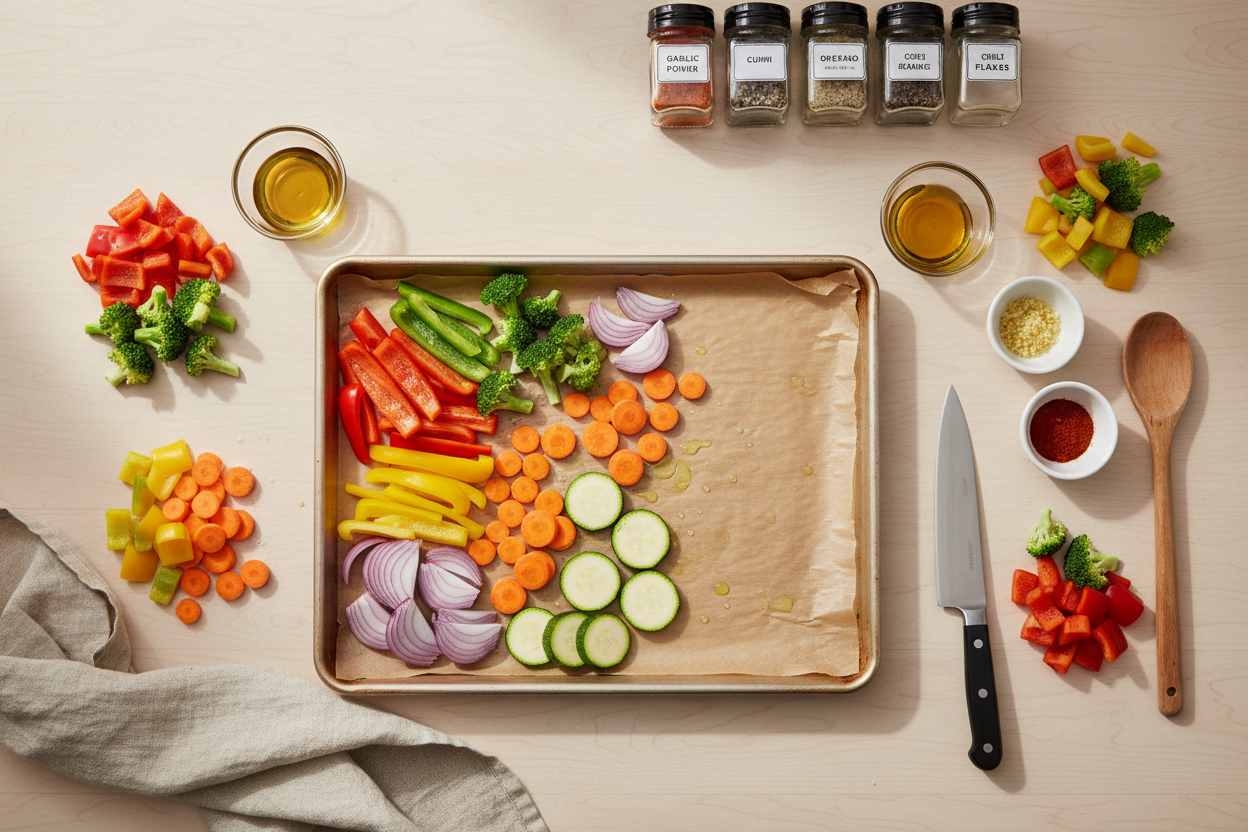Weeknight dinners don’t have to be stressful. With a few smart habits, you can cut prep time in half, reduce kitchen mess, and still serve nourishing, delicious meals your family will love. In this guide, you’ll learn practical, real-world strategies—from batch-prepping veggies to smart seasoning systems—that streamline cooking without sacrificing flavor. As chef Samin Nosrat said, “Good cooking is about developing a relationship with ingredients.” These habits help you build exactly that.
What you’ll learn
- Simple routines that shave 15–30 minutes off dinner
- How to organize your fridge for faster decisions
- Batch-prep methods that keep produce fresh all week
- Quick flavor-boosters rooted in culinary science
Habit 1: Plan 3 anchor meals per week
Instead of planning seven unique dinners, pick three “anchor” meals (e.g., stir-fry, sheet-pan chicken, lentil soup) and repurpose leftovers creatively. This limits decision fatigue and reduces shopping time.
- Example rotation:
- Monday: Ginger-garlic chicken stir-fry + rice
- Wednesday: Lentil and vegetable soup
- Friday: Sheet-pan spiced salmon with roasted veggies
- Leftover spins:
- Stir-fry becomes fried rice
- Lentil soup becomes pasta sauce base
- Roasted veggies become grain bowls or wraps
“Plan less, execute more,” as many culinary pros advise—simplicity wins on busy days.
Habit 2: Pre-chop produce once, use it three times
Set aside 30–45 minutes after grocery shopping to wash, chop, and store hardy produce.
- Best candidates: carrots, bell peppers, broccoli, green beans, cabbage, kale
- Storage tip: Use airtight containers lined with a dry paper towel to absorb moisture and keep veggies crisp.
- Payoff: Faster sautés, salads, and sides—no midweek peeling or chopping.
Credible kitchen science shows that dryness and airflow extend the shelf life of produce.
Habit 3: Build a “flavor shelf” you can reach with eyes closed
Create a go-to lineup of high-impact flavor enhancers that never leave the same shelf.
- Essentials:
- Garlic and onion powder
- Smoked paprika
- Ground cumin and coriander
- Chili flakes
- Dried oregano and thyme
- Lemon pepper
- Sea salt and black pepper
- Quick blends:
- All-purpose: 2 tsp garlic powder, 1 tsp onion powder, 1 tsp paprika, 1 tsp salt, 1/2 tsp black pepper
- Mediterranean: 1 tsp oregano, 1 tsp thyme, 1 tsp garlic powder, 1/2 tsp lemon pepper
- Warm spice: 1 tsp cumin, 1/2 tsp coriander, 1/2 tsp smoked paprika, pinch chili flakes
“Season early and layer often,” notes culinary educator J. Kenji López-Alt—seasoning isn’t a finish line but a roadmap.
Habit 4: Cook grains in bulk and freeze flat
Make a double or triple batch of rice, quinoa, or bulgur. Cool thoroughly, then portion in freezer bags, press flat, and freeze.
- Reheat: Microwave with a damp paper towel or steam on the stovetop
- Benefit: Instant base for bowls, stir-fries, and stews—no 20-minute delay
Habit 5: Embrace sheet-pan and one-pot formulas
Fewer dishes = more consistency. Maintain two formulas:
- Sheet-pan formula:
- Protein: chicken thighs, salmon, chickpeas, or tofu
- Veg: broccoli, carrots, zucchini, or potatoes (cut evenly)
- Seasoning: olive oil + one of your blends + salt
- Roast at 425°F (220°C) for 20–30 minutes, flipping once
- One-pot formula:
- Aromatics: onion + garlic
- Base: tomato, coconut milk, or broth
- Protein + veg + grain/pasta
- Simmer until tender, finish with acid (lemon/lime) and herbs
Habit 6: Pre-mix sauces and dressings for the week
Make 2–3 multipurpose sauces on Sunday. Store in jars for 5–7 days.
- Lemon-herb dressing: olive oil, lemon juice, Dijon, garlic, parsley, salt
- Tahini sauce: tahini, lemon juice, garlic, water, salt, cumin
- Simple soy-ginger: soy sauce, grated ginger, garlic, sesame oil, honey or date syrup
These convert plain proteins and vegetables into flavor-packed meals in seconds.
Habit 7: Keep a “grab-and-cook” protein drawer
Stock fast-cooking proteins you can cook straight from the fridge or freezer:
- Eggs, canned beans, canned tuna, halloumi, paneer
- Pre-portioned chicken thighs, shrimp, extra-firm tofu
- Tip: Pre-marinate tofu or chicken in zip bags and freeze—marinade penetrates as it thaws.
Protein is often the time bottleneck—solving it first accelerates everything else.
Habit 8: Use mise en place trays
Before you start, place pre-measured ingredients on a small tray or board. This reduces back-and-forth and burns less time switching tasks.
- Mini bowls for spices
- Small jars for sauces
- Chopped veg grouped by cooking time
“Organization is the backbone of speed in the kitchen,” says many culinary instructors—mise en place is a professional’s secret weapon you can adopt at home.
Habit 9: Master 10-minute sides
Pair any main with one quick side. Rotate to avoid boredom.
- Garlic green beans: sauté with olive oil, garlic, salt, lemon
- Cucumber-tomato salad: olive oil, lemon, herbs, salt
- Quick cabbage slaw: shredded cabbage, carrot, vinegar, olive oil, salt, cumin
- Microwaved sweet potatoes: fork-prick, microwave 5–8 min, finish with tahini and salt
Habit 10: Label everything with “cook-by” dates
Use painter’s tape and a marker. Label leftovers, sauces, and prepped produce with the date and a “use by” note.
- Reduces waste and guesswork
- Encourages quick decisions at 6 p.m.
Food safety reminder: Refrigerated leftovers are best within 3–4 days per FDA guidance. See: FoodSafety.gov Leftovers.
Habit 11: Finish with acid and herbs
The fastest way to make food taste “restaurant good” is a squeeze of lemon or splash of vinegar plus fresh herbs before serving.
- Try: lemon on roasted vegetables, parsley on stews, mint on grain bowls, chives on eggs
“Salt makes food taste more like itself; acid makes it sing.”
Research on taste perception supports that acidity increases salivation and heightens flavor perception—no extra salt needed.
Habit 12: Clean as you cook with a 3-bucket system
Set out:
- A compost/scrap bowl
- A small soapy sponge bowl
- An empty sink for quick rinses
Ten seconds of tidying between steps saves ten minutes at the end.
Sample 20-Minute Dinner Blueprint
- Base: reheated rice or quinoa
- Protein: quick-seared shrimp or pan-fried tofu
- Veg: pre-chopped broccoli + bell peppers, sautéed 6–8 minutes
- Sauce: soy-ginger or tahini-lemon
- Finish: sesame seeds + lime juice + cilantro
This hits protein, fiber, and flavor—no oven, minimal cleanup.
Pantry and Fridge Essentials Checklist
- Pantry: olive oil, vinegars (apple cider, white wine), soy sauce, tahini, canned tomatoes, beans, grains, pasta, spices
- Fridge: eggs, yogurt, lemons/limes, herbs, salad greens, carrots, bell peppers
- Freezer: peas, corn, spinach, pre-cooked grains, marinated chicken or tofu
FAQs
- How do I keep prepped veggies from getting soggy?
- Dry thoroughly, use breathable containers or paper-towel lining, and avoid salting until cooking.
- What if I don’t have time on Sundays to prep?
- Do “micro-prep”: 10–15 minutes on two weeknights. Chop while something simmers.
- Is batch cooking boring?
- Change sauces and finishing touches (acids, herbs, spices). The base can stay the same while flavors vary.
Conclusion
Small, repeatable habits compound into big weeknight wins. With a stocked pantry, prepped produce, quick sauces, and smart cleanup, you’ll move from “What’s for dinner?” to “Dinner’s done” with confidence. Start with two habits this week—grain batch-cooking and a flavor shelf—and build from there. Your future self at 6:30 p.m. will thank you.









